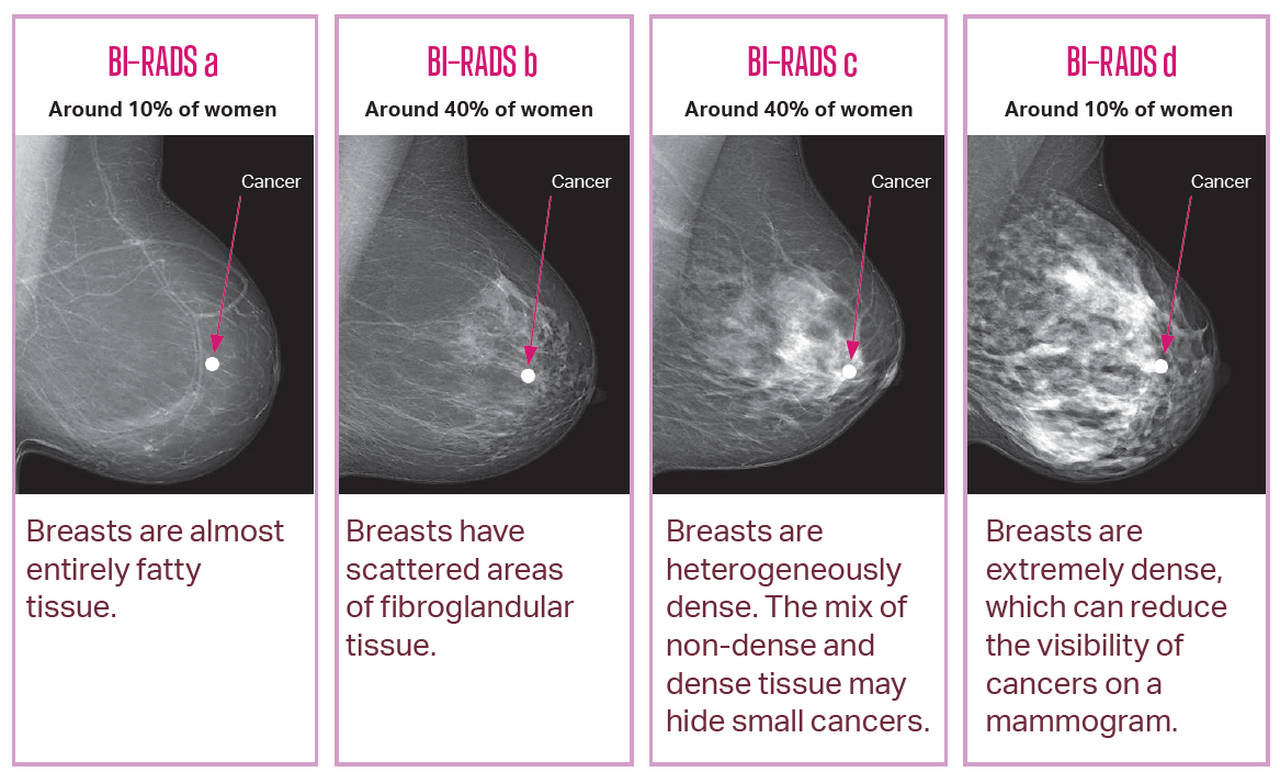Breast density is not a measure of how your breasts feel; it is the amount of glandular tissue in your breasts that appears on a mammogram.
Breasts are made up of 2 main types of tissue – fatty and fibroglandular tissue. Fat appears dark on a screening mammogram while glandular tissue appears ‘dense’ or white – as does breast cancer.
High breast density can increase the risk of breast cancer and can reduce the visibility of breast cancers on a screening mammogram.
From 8 August 2023, BreastScreen SA will measure and report individual breast density for our clients as part of our regular breast cancer screening program. Clients will be provided with their individual breast density category in their results letter.

These pictures illustrate the breast density categories as measured using the Breast Imaging Reporting and Data System (ACR BI-RADS® Atlas 5th Edition).
How is breast density measured?
A regular screening mammogram is the only way to measure breast density.
BreastScreen SA’s research uses a fully-automated software program, Volpara, to measure your breast density as part of your regular screening appointment. There is no additional time or radiation involved.
Does screening take longer than usual?
No. Your screening appointment will take the usual amount of time, which can be as little as 10 minutes. There will be no change to your regular screening experience.
When will I find out my breast density?
You will receive information about your breast density as part of your screening results letter, usually within 14 days of your appointment. Your nominated doctor will also be notified.
What information will I receive about my breast density?
There are 4 categories of breast density, as measured using the Breast Imaging Reporting and Data System (BI-RADS), American College of Radiology (ACR) 5th edition.
You will be told your breast density category. The 4 categories are:
- BI-RADS a (around 10% of women): Breasts are almost entirely fatty tissue.
- BI-RADS b (around 40% of women): Breasts have scattered areas of fibroglandular tissue.
- BI-RADS c (around 40% of women): Breasts are heterogeneously dense. The mix of non-dense and dense tissue may hide small cancers.
- BI-RADS d (around 10% of women): Breasts are extremely dense, which can reduce visibility of cancers on mammograms.
Women with BI-RADS c or d classification are regarded as having high breast density.
What if I don’t receive my breast density?
For a small number of women (3-5%), we are unable to measure breast density due to physical restrictions during your screening appointment, an incomplete screen, or the software not generating an accurate reading.
In these circumstances, you will not be offered a repeat screening appointment as it would involve unnecessary additional exposure to radiation.
Is it common to have high breast density?
Yes. It is common and normal to have high breast density. In fact, approximately 50% of women, aged 40 to 74 years, have dense breast tissue.
If I have high breast density, do I need additional tests?
BreastScreen SA does not currently recommend additional tests for women with high breast density who have no symptoms or other risk factors for breast cancer.
If you are at higher risk of breast cancer due to other risk factors, such as strong family history or the presence of BRCA 1 or 2 gene mutations, please talk to your doctor about your ongoing breast care.
More information on risk factors is available at bcna.org.au/breast-health-awareness/risk-factors
Can breast density change over time?
Yes. Breasts tend to become less dense as women get older, especially after menopause, as the glandular tissue changes and the breasts become more fatty.
Breast density is also influenced by genetic and environmental factors and the hormonal changes that occur throughout a woman’s lifetime, including hormone replacement therapy (HRT) and the combined oral contraceptive pill (COCP).
